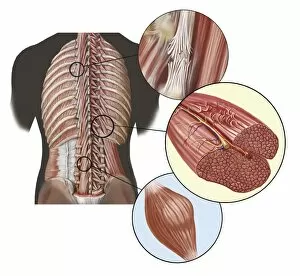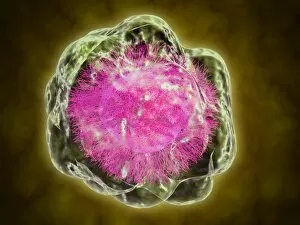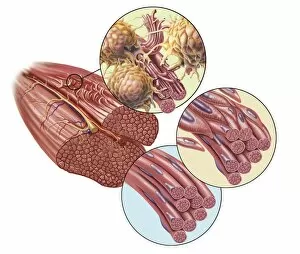Microfilament Collection
Microfilaments, also known as actin filaments, play a crucial role in various cellular processes
All Professionally Made to Order for Quick Shipping
Microfilaments, also known as actin filaments, play a crucial role in various cellular processes. Derived from the protein actin, these thin and flexible structures are found in all eukaryotic cells. In HeLa cells, they can be visualized using a light micrograph C017 / 8299. The intricate network of these filaments provides structural support to the cell and helps maintain its shape. An illustration of muscle contraction showcases how microfilaments interact with myosin to generate movement. As myosin pulls on the actin filaments, muscles contract and enable us to perform physical activities. A close-up of sprain, strain, and spasm in deep back muscles reveals the importance integrity for proper muscle function. Any disruption or damage to these filaments can result in painful conditions that affect our mobility. Comparative illustrations of plant and animal cell anatomy highlight the presence of microfilaments in both types of cells. These filaments contribute to cell division, cytoplasmic streaming, and organelle movement. Conceptual images depicting the cytoskeleton emphasize how microfilaments form an essential part of this dynamic framework within cells. They provide mechanical strength while allowing flexibility for cellular movements. Labels on illustrations demonstrating muscle contraction and plant-animal cell anatomy help identify specific components involved with microfilament interactions. Torn muscle fibers surrounding healing stages remind us that repairing damaged tissues heavily relies on functional microfilament networks. Fibroblast cells play a key role in this process by producing new collagen fibers along the injury site. Fluorescent micrographs showcasing fibroblast cells further highlight their involvement in tissue repair. These specialized cells migrate towards injured areas where they secrete extracellular matrix components necessary for wound healing. Whether it's maintaining cell structure or facilitating muscle contractions and tissue repair processes like wound healing, microfilaments prove indispensable in various biological contexts.











